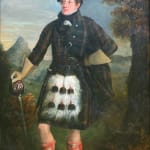Att Thomas Phillips
Size without frame 90 x 62 ins
Further images
Thomas Phillips RA (18 October 1770 – 20 April 1845) was a leading English portrait and subject painter. He painted many of the notable men of the day including scientists, artists, writers, poets and explorers.
Phillips was born at Dudley, then in Worcs. Having learnt glass-painting in Birmingham under Francis Eginton he visited London in 1790 with an introduction to Benjamin West, who found him employment on the painted-glass windows of St George's Chapel at Windsor. In 1791 he became a student at the Royal Academy, where, in 1792 he exhibited a view of Windsor Castle, followed in the next two years by the Death of Talbot, Earl of Shrewsbury, at the Battle of Castillon, Ruth and Naomi, Elijah restoring the Widow's Son, Cupid disarmed by Euphrosyne, and other pictures.
After 1796, he concentrated on portrait-painting. However, the field was very crowded with the likes of John Hoppner, William Owen, Thomas Lawrence and Martin Archer Shee competing for business; consequently, from 1796 to 1800, his exhibited works were chiefly portraits of gentlemen and ladies, often nameless in the catalogue and of no great importance, historically speaking.
In 1804 he was elected an associate of the Royal Academy, together with his rival, William Owen. About the same time he moved to 8 George Street, Hanover Square, London, formerly the residence of Henry Tresham R.A., where he lived for the rest of his life. He became a royal academician in 1808, and presented as his diploma work Venus and Adonis (exhibited the same year), perhaps the best of his creative subjects, apart from Expulsion from Paradise. Meanwhile, he rose steadily in public favour, and in 1806, painted the Prince of Wales, the Marchioness of Stafford, the Marquess of Stafford's Family, and Lord Thurlow. In 1807 he sent to the Royal Academy the well-known portrait of William Blake, now in the NPG, London, which was engraved in line by Luigi Schiavonetti, and later etched by William Bell Scott.
His contributions to the academy exhibition of 1809 included a portrait of Sir Joseph Banks (engraved by Niccolo Schiavonetti), and to that of 1814 two portraits of Lord Byron. In 1818 he exhibited a portrait of Sir Francis Chantrey R.A., and in 1819 one of the poet George Crabbe. His 1822 portrait of Sir Charles Asgill was exhibited at the Royal Academy that same year. In 1825 he was elected professor of painting at the Royal Academy, succeeding Henry Fuseli, and, in order to qualify himself for his duties, visited Italy and Rome in company with William Hilton RA and also Sir David Wilkie whom they met in Florence. He resigned the professorship in 1832, and in 1833 published his "Lectures on the History and Principles of Painting".[1]
Phillips also painted portraits of Walter Scott, Robert Southey, Samuel Taylor Coleridge, Sir Edward Parry, Sir John Franklin, Hugh Clapperton et al. Besides these he painted two portraits of Sir David Wilkie, the Duke of York, Sir Humphry Davy, Michael Faraday and a head of Napoleon, painted in Paris in 1802 not from actual sittings but with Empress Josephine's consent who afforded him opportunities of observing the First Consul while at dinner.
A self-portrait, exhibited in 1844, was one of his last works.
Phillips wrote many occasional essays on the fine arts, especially for Rees's Cyclopeadia, and also a memoir of William Hogarth for John Nichols's edition of that artist's "Works", 1808–17. He was a fellow of the Royal Society and of the Society of Antiquaries. He was also, with Chantrey, Turner, Robertson, and others, one of the founders of the Artists' General Benevolent Institution.
Phillips died at 8 George Street, Hanover Square, London, on 20 April 1845, and was interred in the burial-ground of St John's Wood chapel. He married Elizabeth Fraser of Fairfield, near Inverness.
Augustus Frederick d'Este KCH was the son of the Duke of Sussex and Lady Augusta Murray, grandson of George III and nephew of George IV and WIlliam IV. His parents secretly married in Rome but this was annulled making Augustus illegitimate under English law. He rose to Colonel in the Army and was deputy ranger of St James's Park and Hyde Park, also an active member of the Aborigines Protection Society. He is the earliest recorded person for whom a definite diagnosis of multiple sclerosis can e made. This large than life size portrait has descended through the Murray family.
Join our mailing list
McEwan Gallery Newsletter
* denotes required fields
We will process the personal data you have supplied in accordance with our privacy policy (available on request). You can unsubscribe or change your preferences at any time by clicking the link in our emails.







